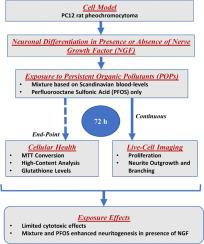当前位置:
X-MOL 学术
›
Toxicol. Lett.
›
论文详情
Our official English website, www.x-mol.net, welcomes your
feedback! (Note: you will need to create a separate account there.)
A human relevant mixture of persistent organic pollutants (POPs) and perfluorooctane sulfonic acid (PFOS) enhance nerve growth factor (NGF)-induced neurite outgrowth in PC12 cells
Toxicology Letters ( IF 2.9 ) Pub Date : 2021-03-01 , DOI: 10.1016/j.toxlet.2020.12.007 Ajay Yadav , Mazia Amber , Denis Zosen , Nils Anders Labba , Eva Henriette Willemijn Huiberts , Johanna Samulin Erdem , Fred Haugen , Hanne Friis Berntsen , Shanbeh Zienolddiny , Ragnhild Elisabeth Paulsen , Erik Ropstad , Lisa Connolly , Steven Verhaegen
Toxicology Letters ( IF 2.9 ) Pub Date : 2021-03-01 , DOI: 10.1016/j.toxlet.2020.12.007 Ajay Yadav , Mazia Amber , Denis Zosen , Nils Anders Labba , Eva Henriette Willemijn Huiberts , Johanna Samulin Erdem , Fred Haugen , Hanne Friis Berntsen , Shanbeh Zienolddiny , Ragnhild Elisabeth Paulsen , Erik Ropstad , Lisa Connolly , Steven Verhaegen

|
Disruption of neurite outgrowth is a marker for neurotoxicity. Persistent organic pollutants (POPs) are potential developmental neurotoxicants. We investigated their effect on neurite outgrowth in PC12 rat pheochromocytoma cells, in absence or presence of nerve growth factor (NGF), an inducer of neuronal differentiation. Cells were exposed for 72 h to a defined mixture of POPs with chemical composition and concentrations based on blood levels in the Scandinavian population. We also evaluated perfluorooctane sulfonic acid (PFOS) alone, the most abundant compound in the POP mixture. Only high concentrations of POP mixture reduced tetrazolium salt (MTT) conversion. High-content analysis showed a decrease in cell number, but no changes for nuclear and mitochondrial cellular health parameters. Robust glutathione levels were observed in NGF-differentiated cells. Live imaging, using the IncuCyte ZOOM platform indicated ongoing cell proliferation over time, but slower in presence of NGF. The pollutants did not inhibit neuritogenesis, but rather increased NGF-induced neurite length. PFOS induced neurite outgrowth to about 50% of the level seen with the POP mixture. Neither the POP mixture nor PFOS affected neurite length in the absence of NGF. Our observations indicate that realistic complex mixtures of environmental pollutants can affect neuronal connectivity via NGF-induced neurite outgrowth.
中文翻译:

持久性有机污染物 (POPs) 和全氟辛烷磺酸 (PFOS) 的人类相关混合物增强神经生长因子 (NGF) 诱导的 PC12 细胞神经突生长
神经突生长的破坏是神经毒性的标志。持久性有机污染物 (POPs) 是潜在的发育神经毒物。我们研究了在不存在或存在神经生长因子 (NGF)(一种神经元分化诱导剂)的情况下,它们对 PC12 大鼠嗜铬细胞瘤细胞中轴突生长的影响。根据斯堪的纳维亚人群的血液水平,将细胞暴露于具有化学成分和浓度的特定持久性有机污染物混合物中 72 小时。我们还单独评估了全氟辛烷磺酸 (PFOS),这是 POP 混合物中含量最高的化合物。只有高浓度的 POP 混合物才能降低四唑盐 (MTT) 的转化率。高内涵分析显示细胞数量减少,但核和线粒体细胞健康参数没有变化。在 NGF 分化的细胞中观察到稳定的谷胱甘肽水平。使用 IncuCyte ZOOM 平台的实时成像表明,随着时间的推移,细胞增殖持续进行,但在 NGF 存在下速度较慢。污染物并没有抑制神经发生,而是增加了 NGF 诱导的神经突长度。全氟辛烷磺酸诱导轴突生长到持久性有机污染物混合物所见水平的 50% 左右。在不存在 NGF 的情况下,POP 混合物和全氟辛烷磺酸都不影响神经突长度。我们的观察表明,环境污染物的现实复杂混合物可以通过 NGF 诱导的神经突生长影响神经元连接。全氟辛烷磺酸诱导轴突生长到持久性有机污染物混合物所见水平的 50% 左右。在不存在 NGF 的情况下,POP 混合物和全氟辛烷磺酸都不影响神经突长度。我们的观察表明,环境污染物的现实复杂混合物可以通过 NGF 诱导的神经突生长影响神经元连接。全氟辛烷磺酸诱导轴突生长到持久性有机污染物混合物所见水平的 50% 左右。在不存在 NGF 的情况下,POP 混合物和全氟辛烷磺酸都不影响神经突长度。我们的观察表明,环境污染物的现实复杂混合物可以通过 NGF 诱导的神经突生长影响神经元连接。
更新日期:2021-03-01
中文翻译:

持久性有机污染物 (POPs) 和全氟辛烷磺酸 (PFOS) 的人类相关混合物增强神经生长因子 (NGF) 诱导的 PC12 细胞神经突生长
神经突生长的破坏是神经毒性的标志。持久性有机污染物 (POPs) 是潜在的发育神经毒物。我们研究了在不存在或存在神经生长因子 (NGF)(一种神经元分化诱导剂)的情况下,它们对 PC12 大鼠嗜铬细胞瘤细胞中轴突生长的影响。根据斯堪的纳维亚人群的血液水平,将细胞暴露于具有化学成分和浓度的特定持久性有机污染物混合物中 72 小时。我们还单独评估了全氟辛烷磺酸 (PFOS),这是 POP 混合物中含量最高的化合物。只有高浓度的 POP 混合物才能降低四唑盐 (MTT) 的转化率。高内涵分析显示细胞数量减少,但核和线粒体细胞健康参数没有变化。在 NGF 分化的细胞中观察到稳定的谷胱甘肽水平。使用 IncuCyte ZOOM 平台的实时成像表明,随着时间的推移,细胞增殖持续进行,但在 NGF 存在下速度较慢。污染物并没有抑制神经发生,而是增加了 NGF 诱导的神经突长度。全氟辛烷磺酸诱导轴突生长到持久性有机污染物混合物所见水平的 50% 左右。在不存在 NGF 的情况下,POP 混合物和全氟辛烷磺酸都不影响神经突长度。我们的观察表明,环境污染物的现实复杂混合物可以通过 NGF 诱导的神经突生长影响神经元连接。全氟辛烷磺酸诱导轴突生长到持久性有机污染物混合物所见水平的 50% 左右。在不存在 NGF 的情况下,POP 混合物和全氟辛烷磺酸都不影响神经突长度。我们的观察表明,环境污染物的现实复杂混合物可以通过 NGF 诱导的神经突生长影响神经元连接。全氟辛烷磺酸诱导轴突生长到持久性有机污染物混合物所见水平的 50% 左右。在不存在 NGF 的情况下,POP 混合物和全氟辛烷磺酸都不影响神经突长度。我们的观察表明,环境污染物的现实复杂混合物可以通过 NGF 诱导的神经突生长影响神经元连接。











































 京公网安备 11010802027423号
京公网安备 11010802027423号